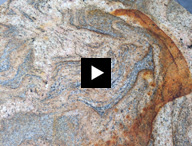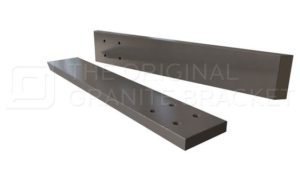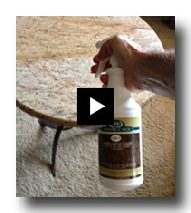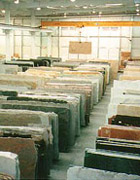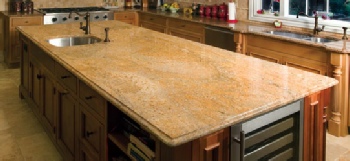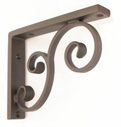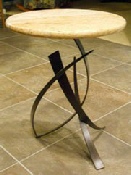Here are proven granite stain removal directions that consistently restore your stone countertops back to their original natural beauty. This guide includes removing stains from granite, marble, and limestone.
We have cleaned granite stains of all types, some by trial and error, but all with great results –
To prevent a granite stain from becoming an issue in the first place, simple granite care and maintenance is required. See How to Clean Granite Countertops.
For cleaning granite, the ONLY product we use or have ever recommended is MB Stone Care MB-
If you do get a stain, here’s what you do . . .
Clean Granite Spills
Blot the spill with a paper towel immediately. Don’t wipe the area, it will spread the spill. Flush the area with plain water and mild soap and rinse several times.
Dry the area with a soft cloth. Repeat as necessary. If the stain remains, refer to the following sections in this guide.
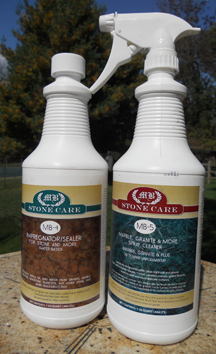
Types of Granite Stains and Cleaning Needed
Oil-
Clean gently with a soft, liquid cleanser with bleach OR household detergent OR ammonia OR acetone OR mineral spirits.
Organic (coffee, tea, fruit, tobacco, paper, food, urine, leaves) May cause a pinkish-
Clean with 12% hydrogen peroxide (hair bleaching strength) and a few drops of ammonia.
Metal (iron rust, copper, bronze) Iron or rust stains are orange to brown in color and follow the shape of the staining object. Copper and bronze stains appear as green or muddy-
(See Making & Using a Poultice below). Deep seated, rusty stains are extremely difficult to remove and the stone may be permanently stained.
Biological (algae, mildew, lichens, moss, fungi) Clean with dilute (1/2 cup in a gallon of water) ammonia OR bleach OR hydrogen peroxide. DO NOT MIX BLEACH AND AMMONIA! THIS COMBINATION PRODUCES A TOXIC AND LETHAL GAS!
Ink (magic marker, pen, ink) Clean with bleach OR hydrogen peroxide (light colored stone only!) OR lacquer thinner or acetone (dark stones only!)
Paint. Small amounts can be removed with lacquer thinner or scraped off carefully with a razor blade. Heavy paint coverage should be removed only with commercial “heavy liquid” paint stripper available from hardware stores and paint centers.
These strippers normally contain caustic soda or lye. Do not use acids or flame tools to strip paint.
Paint strippers can etch the stone surface. Follow the manufacturer’s directions taking care to flush the area thoroughly with clean water. Protect yourself with rubber gloves and eye protection. Work only in well ventilated areas.
Normally, latex or acrylic paint will not cause staining. Oil based paints, linseed oil, putty, caulks and sealants may cause oily stains.
Water Stains. Removing granite water stains is typically not a “stain removal” at all, but rather a removal of the agent that is causing an artificial stain to appear.
Often water stains are rings of granite sealer (especially on black granite). You get rid of them by removing the sealer with denatured alcohol. Simply spray it on and rub in circles with a clean cloth, frequently changing the area of the cloth you are using.
Repeat this several times and go quick because the alcohol evaporates fast.
Scratches and Nicks. Surface scratches may be buffed with dry 0000 steel wool. Deeper scratches and nicks should be repaired and re-
Do light granite countertops stain?
Making and Using a Poultice For Granite Stains
Sometimes stone top care requires removing stains with a poultice. A poultice is a liquid cleaner or chemical mixed with a white absorbent material to form a paste about the consistency of peanut butter.
The poultice is spread over the stained area to a thickness of about ½” with a wood or plastic spatula, covered with plastic, and left to work for 24 to 48 hours. The liquid cleaner or chemical will draw out the stain into the absorbent material.
Poultice procedures may need to be repeated to completely remove a stain.
Poultice Materials
Poultice materials include kaolin, fuller’s earth, whiting, diatomaceous earth, powdered chalk, white molding plaster or talc. Approximately one pound of prepared poultice material will cover one square foot. Do not use whiting or iron-
The reaction will cancel the effect of the poultice. A poultice can also be prepared using white cotton balls, white paper towels or gauze pads.
Cleaning Agents by Stain Type
Oil Based Stains
Poultice with baking soda and water OR one of the powdered poultice materials and mineral spirits.
Organic Stains
Poultice with one of the powdered poultice materials and 12% hydrogen peroxide (hair bleaching strength) OR use acetone instead of the hydrogen peroxide.
Iron Stains
Poultice with diatomaceous earth and a commercially available rust remover. Rust stains are particularly difficult to remove and may be the most difficult granite stain you ever face.
Copper Stains
Poultice with one of the powdered poultice materials and ammonia.
Biological Stains
Poultice with dilute ammonia OR bleach OR hydrogen peroxide. DO NOT MIX BLEACH AND AMMONIA! THIS COMBINATION PRODUCES A TOXIC AND LETHAL GAS!
Applying the Poultice
Prepare the poultice. If using powder, mix the cleaning agent or chemical to a thick paste the consistency of peanut butter. If using paper, soak in the chemical and let drain. Don’t let the liquid drip. Wet the stained area with distilled water. Apply the poultice to the stained area about ¼ to ½ inch thick and extend the poultice beyond the stained area by about one inch. Use a wood or plastic scraper to spread the poultice evenly. Cover the poultice with plastic and tape the edges to seal it. Allow the poultice to dry for about 24 to 48 hours.
The drying process is what pulls the stain out of the stone and into the poultice material. After about 24 hours, remove the plastic and allow the poultice to dry. Remove the poultice from the stain. Rinse with distilled water and buff dry with a soft cloth. Use the wood or plastic scraper if necessary to lift the poultice off the stain. Repeat the poultice application if the stain is not removed. It may take up to five applications for difficult stains.
Care of granite countertops is simple and not time consuming. Chances are granite stains will never be a problem and your tops will look great year after year.
If you have cleaned your granite tops with dish soap, you can remove the soap film buildup with MB-
See Granite Countertop Repair for tips and resources to fix damaged and chipped tops.
See Granite Sealers for sealing granite.
Angie’s List Free Trial
As a granite countertop fabricator and installer, I was approached by Angie’s List but it wasn’t for a paid listing. When dealing with contractors of any kind, quality referrals are your best way to avoid frustration and hassle.
Consider a referral source like Angie’s List to help you find any kind of contractor, not just granite fabricators and installers.
Angie’s List has been around for over a decade and contractors cannot pay to be listed or referred. I use Angie’s List myself, everything from car repair to medical providers. .
Return from Granite Stain to Granite Care Guide

